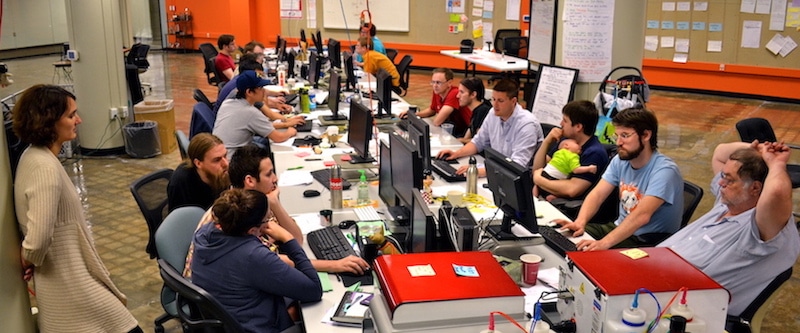Rich Sheridan of Menlo influences at Fortune 100 IT manager to Adopt No Walls Workspace Format
What’s a Menlonian?
It is rare, but increasingly sited, employee or manager who has studied the unique workplace practices at Menlo Innovations in Ann Arbor, MI, and has taken them back to the home office for implementation there. Menlo Innovations was co-founded by PNSQC’s fall keynote speaker, Rich Sheridan, author of “Joy Inc.: How We Built a Workplace People Love.” Sheridan will also be hosting a workshop, Improving Alignment In Your Project Team.
 Thomas A. Paider is one such person. Paider is both an author and the leader of a large team of financial services employees at a Fortune 100 corporation. He was exposed to the Menlo way by Sheridan and his team and adopted many of the Menlonian principles in his workplace. Among the stunning highlights: a 50% reduction in defects every year, increased employee engagement and productivity. All that despite the initial skepticism that Paider had to overcome.
Thomas A. Paider is one such person. Paider is both an author and the leader of a large team of financial services employees at a Fortune 100 corporation. He was exposed to the Menlo way by Sheridan and his team and adopted many of the Menlonian principles in his workplace. Among the stunning highlights: a 50% reduction in defects every year, increased employee engagement and productivity. All that despite the initial skepticism that Paider had to overcome.
We asked him to describe his journey from traditional working environment to one that pairs workers, removes hierarchical and physical barriers, and gathers input from team members and clients before making decisions large and small.
His comments follow:
In The Beginning
“The value of working with a company like Menlo is being able to see in action what you’re learning. Rich Sheridan doesn’t just talk about transforming the workplace, he’s actually done it. Taking a gemba trip to visit the company makes the abstract real. I think that’s why so many of the companies he’s worked with have actually made progress when you can see it, touch it, all of a sudden it’s real, and you believe you can do it too.”
During The Transformation
“Our company is a great example of the power of the Menlo way. What Rich talks about doesn’t just apply to small companies, but too large enterprises as well. Are there things that are different between a company like Menlo and a Fortune 100 organization? Sure, but the broader philosophy and practices still apply. Visit our workplace and you’ll see visuality, transparency, empowered teams, problem-solving, not to mention a focus on making work fun – all things we originally saw coming out of Menlo. One critical element we learned was that Menlo is not about one particular thing, it’s a system of many things, that when put together are incredibly powerful and benefit our staff and our customers.”
Results
“The results have been tremendous as a result of our transformation. Defects were reduced 50% year over year for seven years straight, productivity has increased, employee engagement has increased, costs have come down – these methods have proven that you can increase quality, decrease cost, and deliver results predictably.”
Staff
“Of course the staff was skeptical when we started the transformation. Who can blame them? We changed nearly every aspect of how they did work. From their workspaces to how they interacted with managers to engineering practices – it all changed. But what we found was that when we involved the people doing the work in making the work better, buy in happened at a much greater rate. In fact, that’s probably the most underreported tool in Rich’s arsenal – involve the people. Management doesn’t have all the answers, neither do the frontline staff. But when everyone is involved in process improvement, the chances of success go up dramatically.”
Thomas A. Paider is the author of The Lean IT Field Guide and an IT Executive with a Fortune 100 Financial Services Company.




